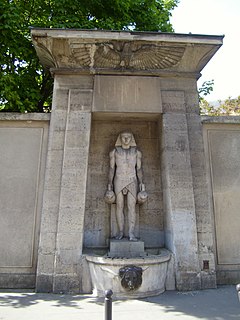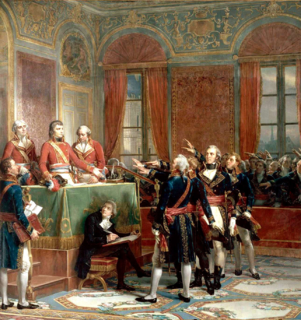
The Jardin du Luxembourg, also known in English as the Luxembourg Gardens, is located in the 6th arrondissement of Paris, France. It was created beginning in 1612 by Marie de' Medici, the widow of King Henry IV of France, for a new residence she constructed, the Luxembourg Palace. The garden today is owned by the French Senate, which meets in the Palace. It covers 23 hectares and is known for its lawns, tree-lined promenades, flowerbeds, model sailboats on its circular basin, and picturesque Medici Fountain, built in 1620.. The name Luxembourg comes from the Latin Mons Lucotitius, the name of the hill where the garden is located.

Louis Tullius Joachim Visconti was an Italian-born French architect and designer.

Jean-Antoine-Gabriel Davioud was a French architect, best known for the 1878 Palais du Trocadéro in Paris which was demolished to make place in 1937 for the Palais de Chaillot.

Louis-Simon Boizot (1743–1809) was a French sculptor whose models for biscuit figures for Sèvres porcelain are better-known than his large-scale sculptures.

The Place du Châtelet is a public square in Paris, on the right bank of the river Seine, on the borderline between the 1st and 4th arrondissements. It lies at the north end of the Pont au Change, a bridge that connects the Île de la Cité, near the Palais de Justice and the Conciergerie, to the right bank. The closest métro station is Châtelet

The Fontaine des Innocents is a monumental public fountain located on the place Joachim-du-Bellay in the Les Halles district in the 1st arrondissement of Paris, France. Originally called the Fountain of the Nymphs, it was constructed between 1547 and 1550 by architect Pierre Lescot and sculptor Jean Goujon in the new style of the French Renaissance. It is the oldest monumental fountain in Paris.

The Medici Fountain is a monumental fountain in the Jardin du Luxembourg in the 6th arrondissement in Paris. It was built in about 1630 by Marie de' Medici, the widow of King Henry IV of France and regent of King Louis XIII of France. It was moved to its present location and extensively rebuilt in 1864-66.

Jean Beausire, was an architect, engineer and fountain-maker and the chief of public works in Paris for King Louis XIV of France and King Louis XV of France between 1684 and 1740, and was the architect of all the public fountains constructed in Paris that period. Several of his fountains still exist and continue to work. Three streets in the 4th arrondissement of Paris today carry his name: Rue Jean-Beausire, Impasse Jean-Beausire, and Passage Jean-Beausire.

The Fontaine de Léda, also sometimes referred to as the Fontaine du Regard, is a Parisian sculptural wall fountain built in 1806–1808 during the reign of Napoleon Bonaparte. The fountain depicts the legend of Leda and the Swan, with a central bas-relief panel by Achille Valois. It was originally located at the corner of the rue de Vaugirard and rue du Regard, hence the alternative name; however, in 1864, during the reconstruction of Paris by Emperor Louis Napoleon, the fountain was moved to the back side of the Medici Fountain in the Luxembourg Garden, where it remains.

Achille-Joseph-Étienne Valois was a French designer and sculptor who studied for a time in the atelier of Jacques-Louis David and whose sculptural works may be seen in Paris. He also studied with Antoine-Denis Chaudet.

The Fontaine de l'Abbaye de Saint-Germain-des-Prés is a fountain constructed in 1715-1717, at the end of the reign of King Louis XIV and the beginning of the reign of Louis XV, to provide drinking water in the neighborhood near the church of Saint Germain-des-Prés, in the 6th arrondissement of Paris. It was originally located at the corner of the Rue Sainte-Marguerite and Rue Childebert. The fountain mechanics were designed by Jean Beausire, the chief of public works and fountain-maker for Louis XIV, who built more than twenty fountains in Paris between 1684 and 1740. The architect was Victor-Thierry Dailly, who in 1715 was commissioned to build a group of houses and the fountain around the parvis of the Church of Saint-Germain-des-Pres.

Fountains in France provided drinking water to the inhabitants of the ancient Roman cities of France, and to French monasteries and villages during the Middle Ages. Later, they were symbols of royal power and grandeur in the gardens of the kings of France. Today, though they no longer provide drinking water, they decorate the squares and parks of French cities and towns.

Rue Bonaparte is a street in the 6th arrondissement of Paris. It spans the Quai Voltaire/Quai Malaquais to the Jardin du Luxembourg, crossing the Place Saint-Germain-des-Prés and the place Saint-Sulpice and has housed many of France's most famous names and institutions as well as other well-known figures from abroad. The street runs through the heart of the fashionable Left Bank and is characterised by a number of 'hôtels particuliers' and elegant apartment buildings as well as being bounded by the river at one end and the park at the other. With fifteen buildings or monuments classified as Monument Historique, it has more such listed sites than any other street in the 6th arrondissement.

The city of Paris has notable examples of architecture of every period from the Middle Ages to the 21st century. It was the birthplace of the Gothic style, and has important monuments of the French Renaissance, the Classical revival, and flamboyant style of the reign of Napoleon III; the Belle Époque, and the Art Nouveau style. The great Paris Universal Expositions of 1889 and 1900 added Paris landmarks, including the Eiffel Tower and Grand Palais. In the 20th century, the Art Deco style of architecture first appeared in Paris, and Paris architects also influenced the postmodern architecture of the second half of the century.

First Consul Napoleon Bonaparte moved into the Tuileries Palace on 19 February 1800 and immediately began to re-establish calm and order after the years of uncertainty and terror of the Revolution. He made peace with the Catholic church; masses were held again in the Cathedral of Notre Dame, priests were allowed to wear ecclesiastical clothing again, and churches to ring their bells. To re-establish order in the unruly city, he abolished the elected position of the Mayor of Paris, and replaced it with a Prefect of the Seine and a Prefect of Police, both appointed by him. Each of the twelve arrondissements had its own mayor, but their power was limited to enforcing the decrees of Napoleon's ministers.






















